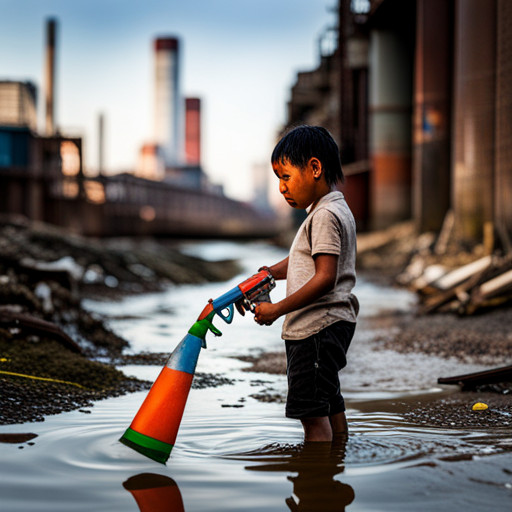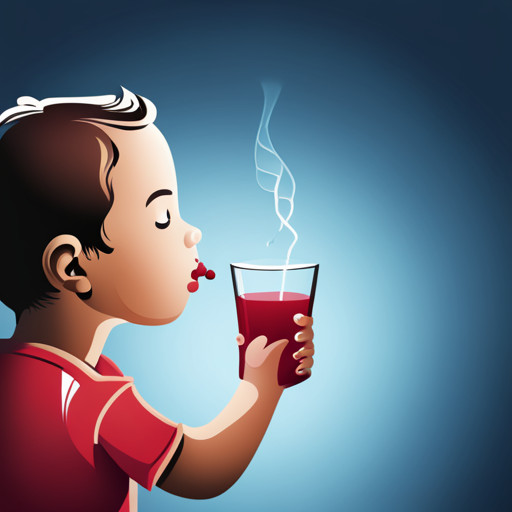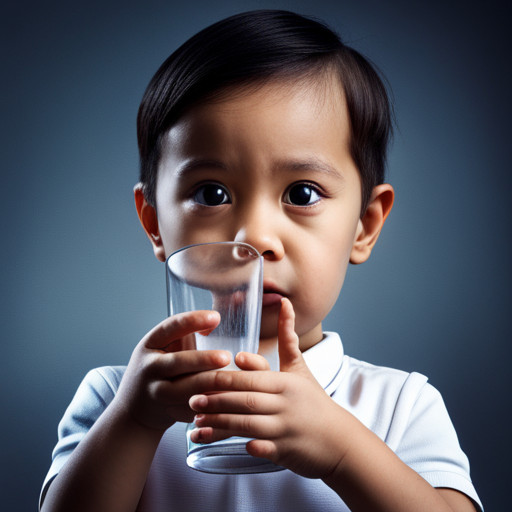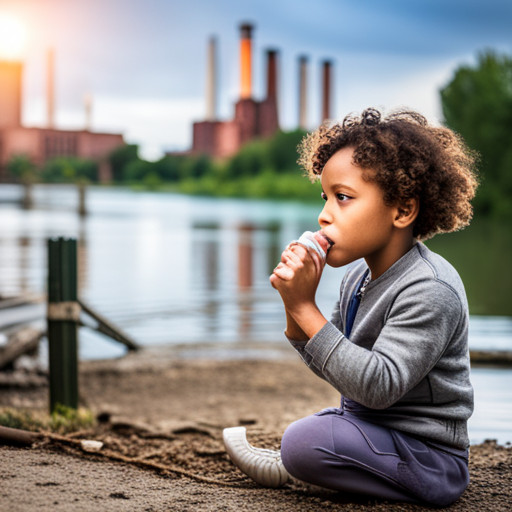Toxins and Toddlers: Understanding the Grim Impact of Polluted Water
This article explores the detrimental effects of waterborne toxins on toddlers' health.

The susceptibility of this age group to environmental pollutants, specifically within water sources, will be scrutinized alongside an analysis of short and long-term health implications.
Preventive measures will also be discussed in conjunction with real-life case studies highlighting the consequences of polluted water on young children.
Key Takeaways
- Toddlers are more vulnerable to the effects of waterborne toxins due to their developing immune systems and lower toxin tolerance.
- Contaminated water can cause acute gastrointestinal illness and diseases like cholera or typhoid fever in young children.
- Prolonged exposure to pollutants can lead to developmental issues and chronic conditions later in life.
- Prevention and protection measures such as hydration alternatives, point-of-use water treatment devices, and public education are essential in safeguarding toddlers from consuming contaminated water.
The Hidden Dangers of Polluted Water

Investigating the hidden dangers of polluted water reveals a myriad of potential health risks, particularly for vulnerable populations such as toddlers. A range of toxin sources contributes to this pollution, including industrial waste, agricultural runoff, and the inefficient treatment of sewage. These toxins can cause a host of complications in adults; however, their effects on young children are much more severe due to their developing immune systems.
Research indicates that infants and toddlers who consume contaminated water can suffer from acute gastrointestinal illness and other diseases like cholera or typhoid fever. In addition to these immediate ailments, prolonged exposure to pollutants can lead to developmental issues and chronic conditions later in life.
Addressing this pressing issue requires comprehensive pollution solutions at both local and global levels. For instance, stricter regulations on industrial waste disposal could significantly reduce the number of harmful chemicals entering water systems. Moreover, investing in advanced sewage treatment plants would help eliminate bacteria and viruses from wastewater before it is released back into natural bodies.
Agricultural practices must also be reassessed since they account for a large proportion of water pollution through nutrient-rich runoff that promotes harmful algal blooms. Promoting sustainable farming methods and implementing strategies like buffer strips or wetlands could curb this source considerably.
Public education remains paramount in combating water pollution as well. Understanding the severity of these toxin sources will encourage better stewardship towards freshwater resources while highlighting the importance of individual actions in maintaining clean water supplies—actions that will ultimately protect those most vulnerable: our children.
How Toddlers Are More Susceptible to Waterborne Toxins

Due to their underdeveloped immune systems and small body mass, young children are more vulnerable to the detrimental effects of harmful substances found in contaminated aquatic environments. This susceptibility extends particularly to waterborne toxins, which can have severe health implications for this demographic.
Toxins present in polluted water can be ingested either directly through consumption or indirectly via food cooked with contaminated water. Young children, given their lower toxin tolerance, are at a greater risk from these contaminants than adults. Toxin tolerance varies depending on age, weight and overall health; however, toddlers often lack the capacity to effectively metabolize or excrete toxins.
Ingestion of toxic substances can lead to acute illnesses such as gastroenteritis or longer-term conditions like developmental disorders and growth stunting. Moreover, chronic exposure may increase risk for serious diseases including various types of cancer later in life.
Despite these alarming possibilities, solutions do exist that can safeguard young ones' health. Hydration alternatives are paramount among these protective measures. These include commercially bottled water – regulated by stringent safety standards – or boiled tap water which kills most bacteria and viruses rendering it safe for consumption.
Furthermore, use of point-of-use water treatment devices such as filters can reduce contamination levels significantly. As another option, rainwater harvesting followed by appropriate treatment processes could provide a safer source of hydration.
The Short and Long-Term Effects of Toxins on Children’s Health

Exposure to harmful substances in contaminated aquatic environments can lead to both immediate and long-lasting health concerns for young children. These health concerns range from acute illnesses such as gastroenteritis to more chronic conditions like developmental disorders and growth stunting.
Toxin sources are diverse, encompassing a variety of pollutants including heavy metals, pesticides, bacteria, and viruses.
Once ingested by toddlers through direct consumption or indirect exposure via food chains, these toxins can cause detrimental health implications. Immediate symptoms may include nausea, vomiting, and diarrhea. However, the truly insidious nature of toxin exposure lies in its ability to inflict long-term damage.
Neurological impairments resulting from prolonged exposure have been linked with lowered cognitive function and behavioral problems in later life. Furthermore, certain toxins can disrupt endocrine function leading to growth deficiencies, while others may induce immunotoxic effects that increase susceptibility to infections and diseases over time. Particularly concerning is the potential carcinogenic risk associated with some toxins, which could predispose individuals towards developing cancer during adulthood.
Mitigation strategies should prioritize prevention of water source contamination as well as early detection and treatment of toxin-induced ailments in exposed populations. This involves comprehensive monitoring of water quality standards accompanied by healthcare interventions that target at-risk groups, especially toddlers who bear a disproportionate burden of toxic exposure due to their physiological vulnerabilities.
Measures to Protect Your Toddler From Polluted Water

Protective measures against contaminated aquatic environments must be prioritized to ensure the health and well-being of young children, taking into account both immediate and long-term risks. These measures are imperative, considering the potential harm posed by toxins found in polluted water sources which drastically affect a child's developmental processes.
One effective strategy is the use of Filtering Solutions. These may range from simple activated carbon filters capable of removing chlorine and sediments, to more complex reverse osmosis systems designed to eliminate harmful substances such as lead, arsenic or nitrates. It is crucial that these solutions are maintained regularly to optimize their effectiveness.
In situations where filtering solutions are not available or feasible, Bottled Alternatives offer a viable option. However, caution needs to be exercised when relying on bottled water due to potential issues related to storage conditions and plastic components leaching into the water over time. Moreover, it is advisable for consumers to verify whether these alternatives have been sourced from trustworthy suppliers who adhere strictly to quality control standards.
The introduction of these protective measures does not negate the importance of ongoing research into improved methods for safeguarding children's health against pollutants in water sources. The implementation of stricter regulations governing industrial waste disposal can also contribute significantly towards reducing contamination levels in natural water bodies.
Through combined efforts encompassing technological advancements in filtration methods, stringent regulatory policies and increased consumer awareness about safe water practices, it is hoped that exposure risks for young children can be considerably mitigated.
Case Studies: Real-Life Consequences of Water Pollution on Toddlers

Detailed examination of real-life scenarios elucidates the detrimental effects that contaminated aquatic environments can have on young children's health and development. In regions where industrial activity contributes significantly to pollution origins, water sources often become reservoirs for hazardous substances such as lead, mercury, and arsenic. Such toxins can seriously impede a child's cognitive and physical progress when ingested in substantial amounts.
Several case studies reveal this grim reality. For instance, research conducted in Bangladesh uncovered an alarming correlation between exposure to arsenic-contaminated water and delayed motor skill development among toddlers. Similarly, in Flint, Michigan (USA), the community has been grappling with grave health consequences due to lead-tainted public water supply - a significant number of affected individuals are toddlers who now exhibit learning difficulties.
Nonetheless, understanding these pollution origins also opens pathways towards contamination solutions. The implementation of strict environmental regulations can limit industrial effluents releasing into natural water bodies. Enhanced filtration technologies at communal water supply points can screen out harmful toxins before they reach households.
Community awareness is another crucial aspect of contamination solutions. By disseminating information about potential hazards lurking in local waters and ways to avoid them, societies can protect their youngest members from harm more effectively.
Frequently Asked Questions
What Are the Most Common Toxins Found in Polluted Water?
Common toxins in polluted water include heavy metals, pesticides, and microorganisms. These toxin sources necessitate the implementation of effective water purification methods to ensure safe consumption and prevent detrimental health impacts.
How Does the Immune System of a Toddler React to These Toxins?
Exposure to toxin sources in polluted water can compromise a toddler's immune system. The immature immunity, coupled with inadequate hygiene practices, struggles to combat these environmental hazards, leading potentially to chronic diseases and developmental issues.
Can These Toxins Impact the Mental Development of Toddlers?
Research indicates a potential link between toxin exposure during early childhood and impaired cognitive development, highlighting the crucial role of parental education in mitigating negative health outcomes related to environmental contaminants.
Are There Any Medications or Treatments to Counteract the Effects of These Toxins in Toddlers?
Preventive measures and nutritional support constitute the primary response to toxin exposure in toddlers. While no specific medications exist, supportive therapy, including hydration and symptomatic treatment, aids in mitigating the effects of these toxins.
Are There Any Specific Geographical Areas More Prone to Water Pollution and the Resultant Health Issues in Toddlers?
Certain geographical areas, particularly those with high industrial activity or deficient waste management systems, are more susceptible to water pollution. Consequently, local toddler populations may experience an increased risk of exposure to harmful toxins.
Conclusion
In conclusion, the deleterious consequences of polluted water on toddlers' health cannot be overlooked. It is crucial to implement protective measures and encourage research into lessening these effects.
Society must strive for clean and safe water sources to ensure the long-term wellbeing of children worldwide. The case studies underscore the urgency of this global issue, highlighting the need for immediate action in combating water pollution.

This post has been generated by AI and was not reviewed by editors. This is Not legal advice. Please consult with an attorney.




